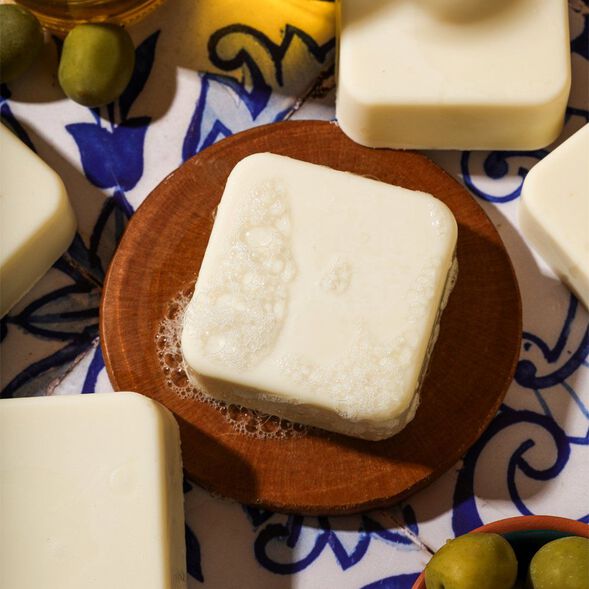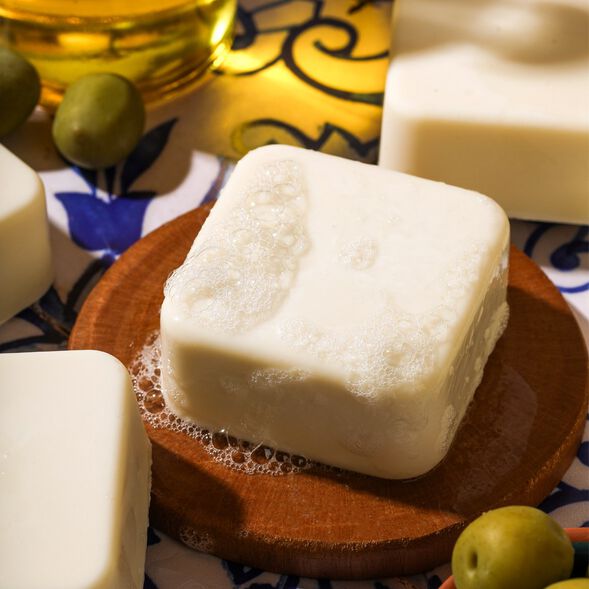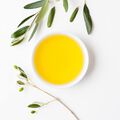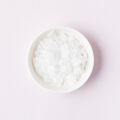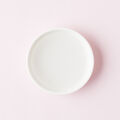
Classic Castile Soap Project
- Skill Level: Beginner
- Time: 1 hour
- Yield: About 22 oz. of soap
Project Description
To enjoy the optimal castile lather, we recommend allowing the soap to cure for one year. Without the proper cure time, the lather is extremely dense and and can feel slimy. It can be hard to wait, but you'll be rewarded with extremely gentle and luxurious soap. Learn more about castile soap here.
Beause castile soap needs a long cure, we recommend skipping fragrance oil. After a year of curing, the fragrance may be very faint.
You will need:
- 6 Cavity Square Silicone Mold
- 16 oz. Olive Oil (100%)
- 2.1 oz. Sodium Hydroxide Lye
- 4.7 oz. Distilled Water
- 1 tsp. Sodium Lactate (optional)
Follow these steps:
1
Slowly and carefully add 2.1 ounces of lye to 4.7 ounces of distilled water and gently stir until the lye has fully dissolved and the liquid is clear. Set aside to cool. Optional: Add 1 teaspoon sodium lactate to help the bars harden more quickly.
2
Measure 16 ounces olive oil into the medium heat-safe container. Heat in the microwave until it's about 100-110° F. Allow the lye water to cool to 100-110° F or below (and ideally within 10 degrees of each other).
3
Place your stick blender into the bowl. Gently tap it on the bottom several times to release any bubbles that got trapped by the stick blender head. This is called “burping."
4
Once bubbles no longer rise to the surface, gently pour the lye water into the bowl.
5
Turn on the stick blender and pulse several times. You'll immediately see the lye and oils come together and create a creamy yellow color. Alternate between pulsing the stick blender and using it to stir for about 30-60 seconds.
6
You may notice the soap starting to lighten in color. It will also get thicker. Once the soap is a texture of very thin pudding, pour the soap into each cavity of the mold.
7
Tap the mold on the counter to pop any air bubbles. Spray the top with 99% isopropyl alcohol to help prevent soda ash.
8
Allow the soap to sit in the mold for 1-2 days. Unmold each bar and cure the soap in a cool, dry place with plenty of airflow. That allows excess water to evaporate, which makes the bars firmer and last longer in the shower. We recommend curing castile soap for about one year. Enjoy!
Tutorial credits
Photographer: Amanda Kerzman

Classic Castile Soap Project
- Skill Level: Beginner
- Time: 1 hour
- Yield: About 22 oz. of soap
Project Description
To enjoy the optimal castile lather, we recommend allowing the soap to cure for one year. Without the proper cure time, the lather is extremely dense and and can feel slimy. It can be hard to wait, but you'll be rewarded with extremely gentle and luxurious soap. Learn more about castile soap here.
Beause castile soap needs a long cure, we recommend skipping fragrance oil. After a year of curing, the fragrance may be very faint.
You will need:
- 6 Cavity Square Silicone Mold
- 16 oz. Olive Oil (100%)
- 2.1 oz. Sodium Hydroxide Lye
- 4.7 oz. Distilled Water
- 1 tsp. Sodium Lactate (optional)
Follow these steps:
1
Slowly and carefully add 2.1 ounces of lye to 4.7 ounces of distilled water and gently stir until the lye has fully dissolved and the liquid is clear. Set aside to cool. Optional: Add 1 teaspoon sodium lactate to help the bars harden more quickly.
2
Measure 16 ounces olive oil into the medium heat-safe container. Heat in the microwave until it's about 100-110° F. Allow the lye water to cool to 100-110° F or below (and ideally within 10 degrees of each other).
3
Place your stick blender into the bowl. Gently tap it on the bottom several times to release any bubbles that got trapped by the stick blender head. This is called “burping."
4
Once bubbles no longer rise to the surface, gently pour the lye water into the bowl.
5
Turn on the stick blender and pulse several times. You'll immediately see the lye and oils come together and create a creamy yellow color. Alternate between pulsing the stick blender and using it to stir for about 30-60 seconds.
6
You may notice the soap starting to lighten in color. It will also get thicker. Once the soap is a texture of very thin pudding, pour the soap into each cavity of the mold.
7
Tap the mold on the counter to pop any air bubbles. Spray the top with 99% isopropyl alcohol to help prevent soda ash.
8
Allow the soap to sit in the mold for 1-2 days. Unmold each bar and cure the soap in a cool, dry place with plenty of airflow. That allows excess water to evaporate, which makes the bars firmer and last longer in the shower. We recommend curing castile soap for about one year. Enjoy!
Tutorial credits
Photographer: Amanda Kerzman
You will need:
- 6 Cavity Square Silicone Mold
- 16 oz. Olive Oil (100%)
- 2.1 oz. Sodium Hydroxide Lye
- 4.7 oz. Distilled Water
- 1 tsp. Sodium Lactate (optional)
Follow these steps:
1
Slowly and carefully add 2.1 ounces of lye to 4.7 ounces of distilled water and gently stir until the lye has fully dissolved and the liquid is clear. Set aside to cool. Optional: Add 1 teaspoon sodium lactate to help the bars harden more quickly.
2
Measure 16 ounces olive oil into the medium heat-safe container. Heat in the microwave until it's about 100-110° F. Allow the lye water to cool to 100-110° F or below (and ideally within 10 degrees of each other).
3
Place your stick blender into the bowl. Gently tap it on the bottom several times to release any bubbles that got trapped by the stick blender head. This is called “burping."
4
Once bubbles no longer rise to the surface, gently pour the lye water into the bowl.
5
Turn on the stick blender and pulse several times. You'll immediately see the lye and oils come together and create a creamy yellow color. Alternate between pulsing the stick blender and using it to stir for about 30-60 seconds.
6
You may notice the soap starting to lighten in color. It will also get thicker. Once the soap is a texture of very thin pudding, pour the soap into each cavity of the mold.
7
Tap the mold on the counter to pop any air bubbles. Spray the top with 99% isopropyl alcohol to help prevent soda ash.
8
Allow the soap to sit in the mold for 1-2 days. Unmold each bar and cure the soap in a cool, dry place with plenty of airflow. That allows excess water to evaporate, which makes the bars firmer and last longer in the shower. We recommend curing castile soap for about one year. Enjoy!
Tutorial credits
Photographer: Amanda Kerzman


